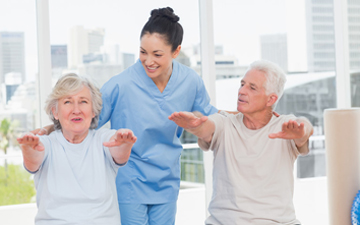 In adulthood, hormones changes and metabolism slows. Osteoarthritis is more common, the kidneys may not function well and the effects of pollution may impair lung capacity. Despite all these changes, experts say that age is not a barrier to start exercising. In fact, you could be better off with exercise. Regular exercise is proven to improve a number of aging factors such as stress, obesity, heart disease and diabetes. The longer you’re physically active, the less you’ll notice getting older.
In adulthood, hormones changes and metabolism slows. Osteoarthritis is more common, the kidneys may not function well and the effects of pollution may impair lung capacity. Despite all these changes, experts say that age is not a barrier to start exercising. In fact, you could be better off with exercise. Regular exercise is proven to improve a number of aging factors such as stress, obesity, heart disease and diabetes. The longer you’re physically active, the less you’ll notice getting older.
Regular exercise address stress and cholesterol, improve bodily functions, keep you from becoming overweight, and boost your self-confidence. If you haven’t made physical activity a routine, you can start in your forties or later. To ensure that your routine is safe, painless and enjoyable, stay low on intensity and duration initially. Here are some precautions to take when you start exercising later in life:
- Consult your family physician: It’s recommended that you consult your doctor before you start your exercise program. This is necessary to evaluate how fit you are. While brisk walking, swimming and aerobics are good to start with, it’s advisable to have a complete medical check-up done to check for chronic medical conditions.
- Set realistic goals: Be aware of your limitations and set realistic goals to experience good results. The focus of the first few months of exercise should be to build good cardiovascular fitness, stamina and endurance. So it’s better to start with minimal-intensity exercises.
- Enjoy your workout: Don’t push yourself too hard. Enjoy your workout sessions. If you lack motivation, find a group exercise or friends with the same fitness levels and keep up the workout till it becomes a habit.
- Don’t ignore warming up: The warm-up session prepares the body for exercise by gradually increasing heart rate and circulation. It will loosen the joints and increase the blood flow to the muscles. Stretching the muscles prepares them for physical activity and prevents injuries. Begin a workout by stretching the shoulders, chest, neck, trunk, lower back, posterior and anterior legs and ankles for at least 10 minutes.
- Know how to execute the exercises: You should know how to execute exercises properly or else you could end up getting injured. Ensuring correct posture will reduce stress on the muscle groups, ensure that the core muscles engage more effectively, and result in maximum output with minimum stress. Consider exercising under a good, experienced trainer.
- Know when to stop: Some pain and discomfort is common among late beginners. However, you should stop exercising if you experience severe discomfort such as joint or musculoskeletal pain or chest pain. These are could be signs that merit medical attention.
A healthy diet is also critical for healthy aging. When you start out on your exercise program, gradually change your diet by adding more complex carbohydrates like brown or red rice, whole wheat products, soya products, beans, ascorbic- acid-containing fruits, green leafy vegetables, grainy bread and pulses. Pack in protein with egg whites, lean cuts of chicken and fish, milk, soya and pulses. Drink lots of water to stay hydrated.
